How ABA therapy can be used to improve focus and attention
July 18, 2025
Unlocking Focus: The Power of ABA Therapy in Enhancing Attention in Children

Understanding the Role of ABA in Attention Improvement
Applied Behavior Analysis (ABA) is a proven therapeutic approach that plays a crucial role in helping children, especially those with autism and ADHD, improve their focus and attention. By utilizing a variety of structured techniques, ABA therapy targets core behavioral and attentional challenges, fostering better engagement and social functioning. This article explores how ABA can be strategically used to enhance attentional skills through specific strategies, techniques, and activities,Supporting children's developmental progress.
Core Strategies Used in ABA to Boost Attention
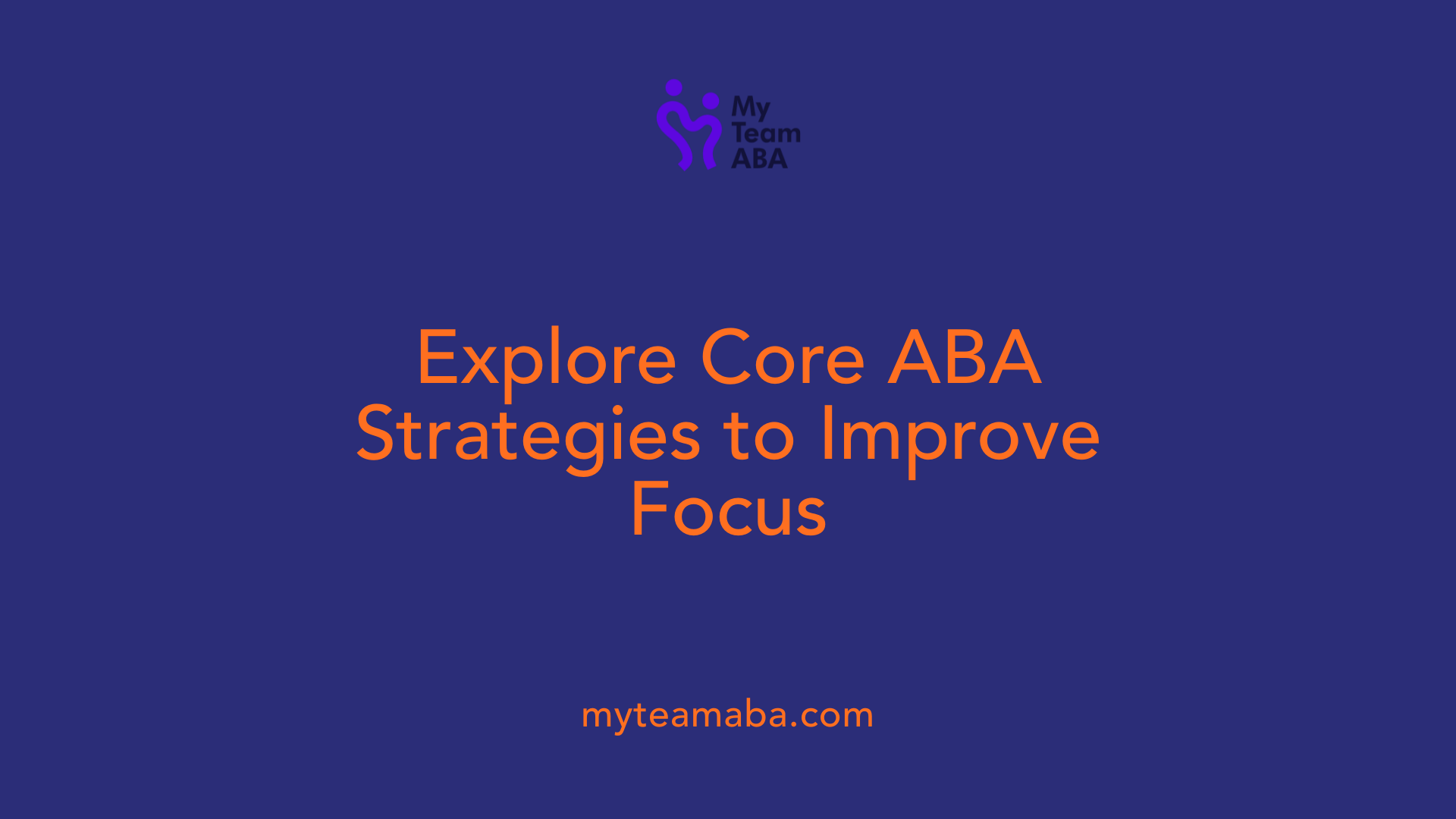
What strategies or activities are used in ABA therapy to enhance attention?
ABA therapy incorporates a variety of methods designed to improve a child's ability to focus and sustain attention. These techniques are evidence-based and tailored to meet individual needs.
One prominent approach is Discrete Trial Training (DTT). This structured activity involves short, controlled teaching segments where specific skills are broken down into manageable steps. Each trial provides immediate feedback, helping children stay focused on the task and learn more efficiently.
Visual supports and cues play a vital role in maintaining attention. These include visual schedules, charts, and attention cues that help children understand what is expected of them. Modeling desired behaviors, using pictures or symbols, guides children to recognize and sustain attention during activities.
In addition, natural environment teaching involves integrating learning into real-life situations. Activities like play, mealtime, or community outings create opportunities for children to practice attention skills in familiar, motivating contexts.
Reinforcement techniques are essential for encouraging attention. Positive reinforcement, such as praise, tokens, or points, motivates children to stay engaged. Reward systems help solidify attentive behaviors and make learning enjoyable.
Environmental modifications also support attention development. Strategies include minimizing distractions, establishing clear and predictable routines, and organizing the space to focus on relevant stimuli. These adjustments create a conducive setting for children to improve their focus.
Together, these methods work synergistically to help children with autism strengthen their attention span and focus, ultimately promoting better learning and social engagement.
The Benefits of ABA for Children with Attention Difficulties
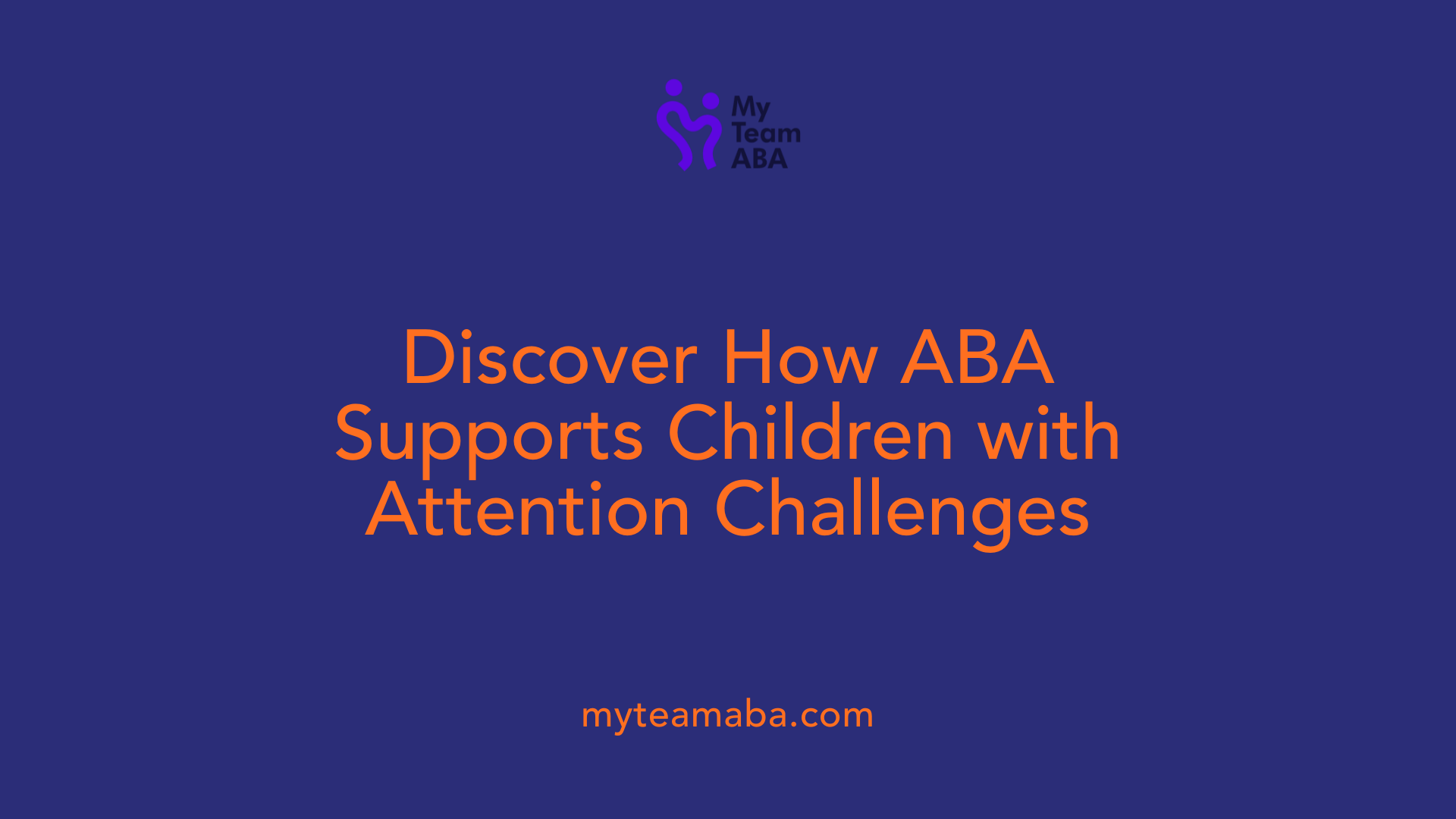
What are the benefits of ABA therapy for children with attention-related challenges, such as autism or ADHD?
Applied Behavior Analysis (ABA) therapy offers numerous advantages for children facing attention issues, including autism and ADHD. Its structured, evidence-based approach targets key areas such as improving attention span, reducing impulsivity, and enhancing behavioral regulation.
One of the primary benefits of ABA is its ability to foster better focus in children. Through techniques like positive reinforcement, visual cues, and clear instructions, ABA helps children learn to concentrate on tasks for longer periods. For example, establishing routines, using simple reminders, and incorporating reinforcement systems can significantly enhance a child's ability to focus, decrease distractibility, and manage sensory inputs.
In children with autism, ABA supports the development of language and social skills. Techniques such as discrete trial training, task analysis, and social skills training enable children to grasp socially acceptable behaviors gradually while reducing problematic behaviors. Augmentative and alternative communication (AAC) devices can further aid non-verbal children in expressing themselves, fostering both communication and focus.
Children with ADHD benefit from ABA's strategies to control impulsive behaviors by reinforcing patience and task persistence. Combining ABA with medication has been shown to produce better outcomes, including decreased impulsivity and improved social interactions. Behavioral interventions like matching, imitation, and manding help teach children how to engage more effectively with peers and adults.
Furthermore, ABA therapy promotes increased independence by teaching self-management skills. As children develop better control over impulses and sensory sensitivities, they can navigate daily routines more smoothly, resulting in improvements in academic performance and social participation.
In addition, ABA incorporates sensory integration activities—such as sensory diets, tactile play, and visual-motor exercises—to help children manage sensory sensitivities that may interfere with focus.
Overall, ABA's individualized techniques support behavioral improvements and skill development, ultimately contributing to a higher quality of life for children with attention-related challenges.
| Technique | Purpose | Benefit |
|---|---|---|
| Positive Reinforcement | Encourage desired behaviors | Improves focus, reduces disruptive actions |
| Visual Supports | Provide clear cues | Enhances understanding and attention |
| Discrete Trial Training | Structured learning | Builds foundational skills quickly |
| Task Analysis | Break tasks into steps | Increases successful task completion |
| Self-Management | Promotes independence | Encourages control over actions |
| Sensory Integration Activities | Manage sensory sensitivities | Reduces distractibility |
As a versatile and scientific approach, ABA therapy continues to adapt and incorporate new techniques aimed at improving attention and behavioral regulation in children. Supported by research, it remains a cornerstone in managing attention-related issues in autism and ADHD.
Improving Focus: How ABA Techniques Shape Attention Skills
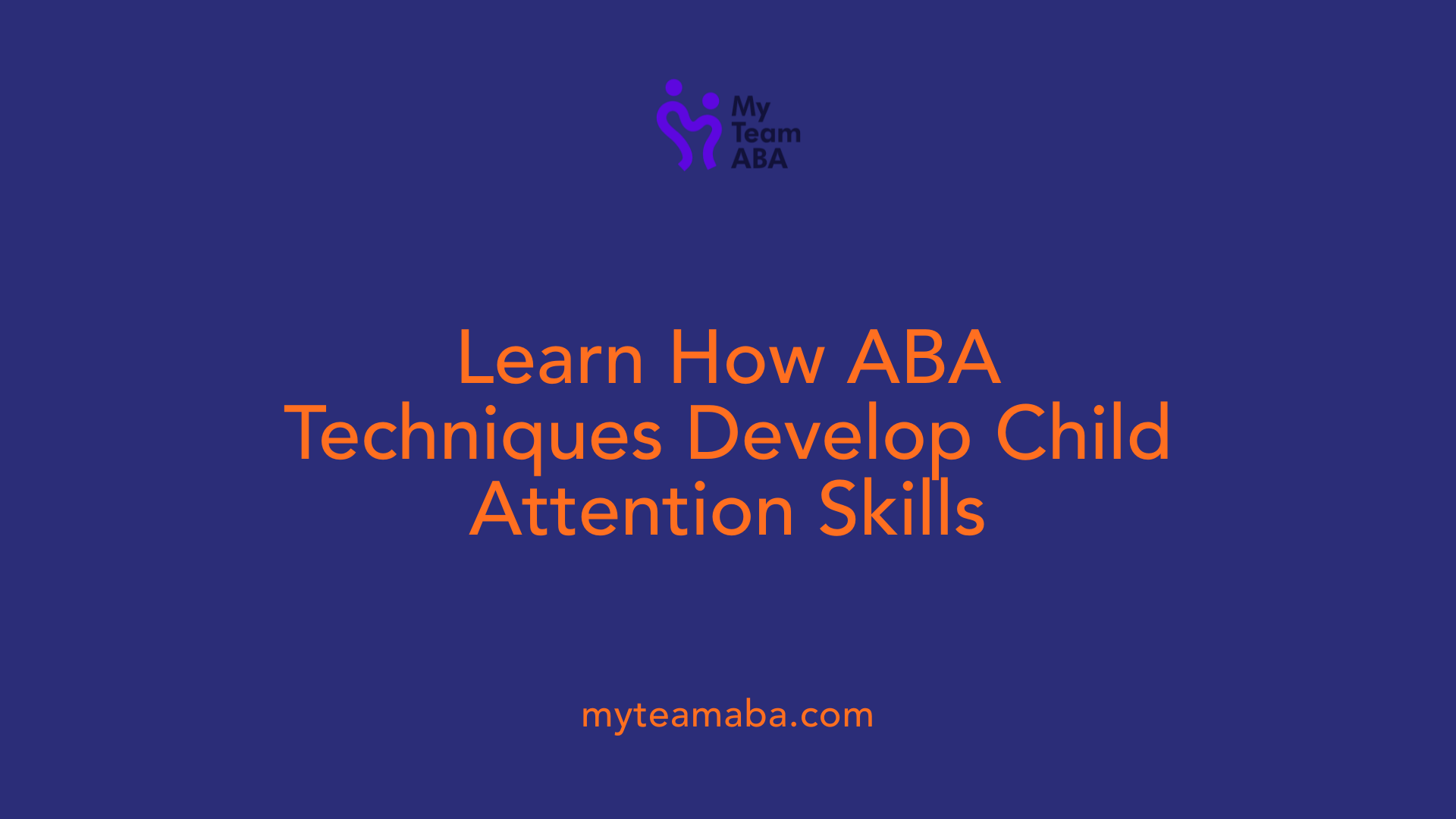
How does ABA therapy improve focus and attention in children?
ABA therapy enhances a child's ability to focus by using personalized, structured methods that promote attentive behaviors. It emphasizes positive reinforcement, rewarding children for maintaining attention and completing tasks, which encourages the repetition of those behaviors.
Consistent routines and clear instructions help children understand expectations, reducing distractions and increasing their ability to concentrate. Techniques like task analysis break complex activities into manageable steps, making it easier for children to stay engaged.
Differential reinforcement plays a vital role by rewarding desired behaviors—such as staying focused—and not reinforcing distractive behaviors. This selective reinforcement shapes attention span over time.
In addition, ABA involves strategies like prompting and fading, where prompting guides behavior initially and gradually lessens as the child gains independence. These methods foster self-regulation, enabling children to control impulses and sustain attention.
Teaching social skills like joint attention—where a child and caregiver share focus on an object or event—further boosts attention skills. This shared focus encourages children to attend to social cues and develop better concentration in social contexts.
Overall, ABA creates an environment where children learn to manage their impulses, stay engaged, and adapt better to social situations. The combined use of reinforcement, routines, task breakdown, and social skills training helps children develop stronger focus and attention capabilities, leading to improved behavioral self-control and academic performance.
Supporting Attention and Communication Development through ABA
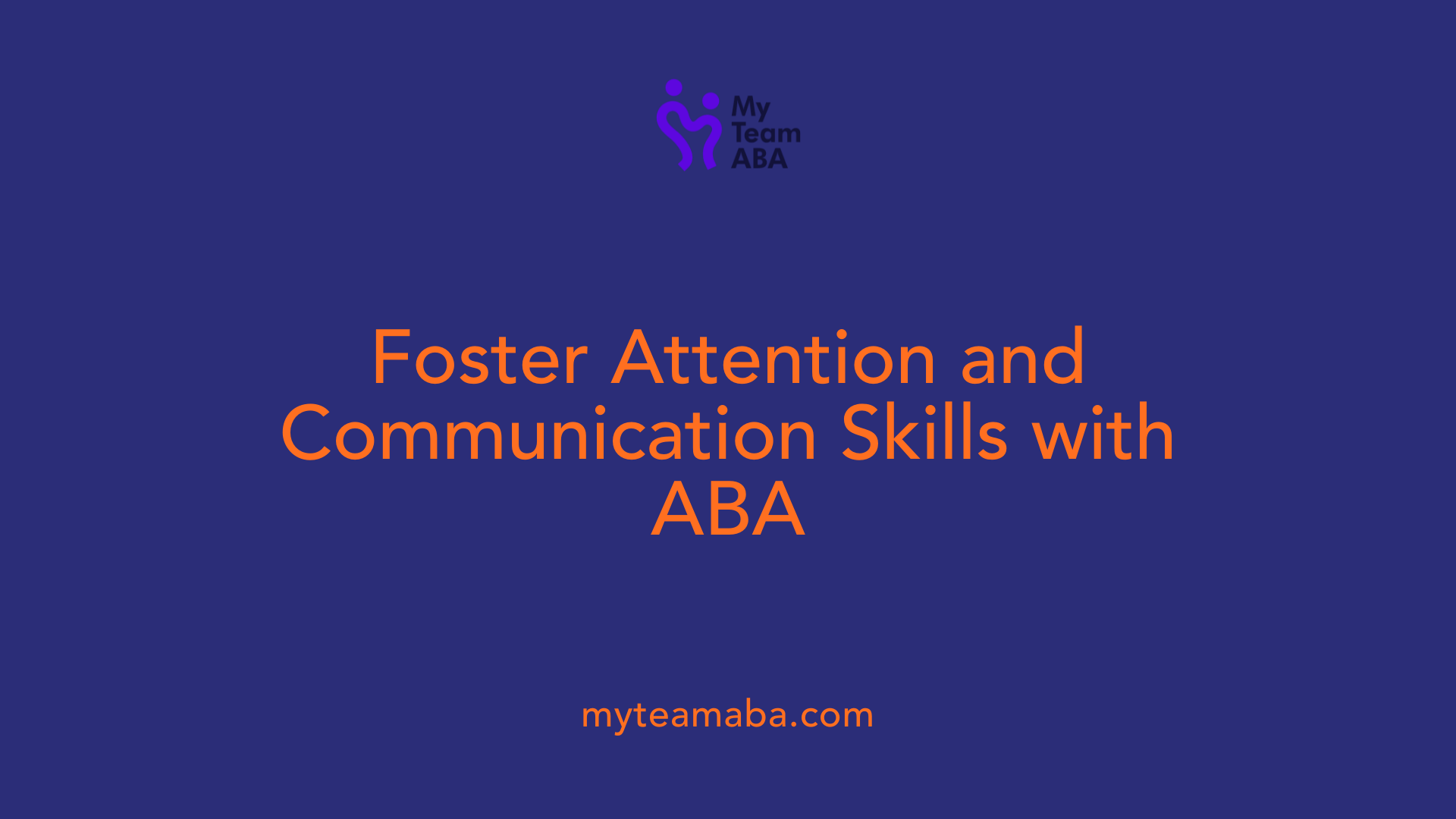
How does ABA therapy support attention and communication development?
ABA therapy plays a significant role in fostering attention and communication skills in children with autism and ADHD. It employs structured, evidence-based techniques to help children focus on relevant stimuli and engage more effectively in social interactions. One cornerstone of ABA is promoting joint attention—where a child shares focus on an object or activity with another person—which is essential for social and language development.
Specific strategies such as prompting, modeling, and reinforcement are tailored to each child's needs. For example, therapists may guide a child to look at an object or make eye contact through subtle prompts, then reinforce this behavior with praise or rewards. Over time, these interventions help children learn to sustain attention and participate in shared experiences.
ABA also incorporates verbal behavior strategies, including teaching mands (requests), tacts (labels), and echoics (repeating sounds), which are fundamental components of functional communication. These strategies help children express needs and respond to social cues more effectively.
For children who are non-verbal or have limited speech, augmentative and alternative communication (AAC) devices such as picture exchange communication systems (PECS) or speech-generating devices are integrated into ABA programs. These tools enable children to communicate purposefully, reducing frustration and improving social engagement.
Beyond direct teaching, ABA uses natural environment teaching (NET), which involves embedding learning opportunities in everyday settings. This approach helps children generalize skills like attention and communication across different environments and people, making the learning more functional.
Additional methods like prompting, modeling, and providing reinforcement reinforce desired behaviors. For instance, a therapist might model a word or action and then prompt the child to imitate it, gradually fading prompts as the child gains independence. Reinforcements such as praise, tokens, or points motivate children to practice these skills consistently.
By systematically combining these techniques, ABA supports children in developing stronger attentional control and more effective communication, both of which are vital for their social success and overall development.
ABA Methods: Matching, Imitation, and Manding for Attention Enhancement
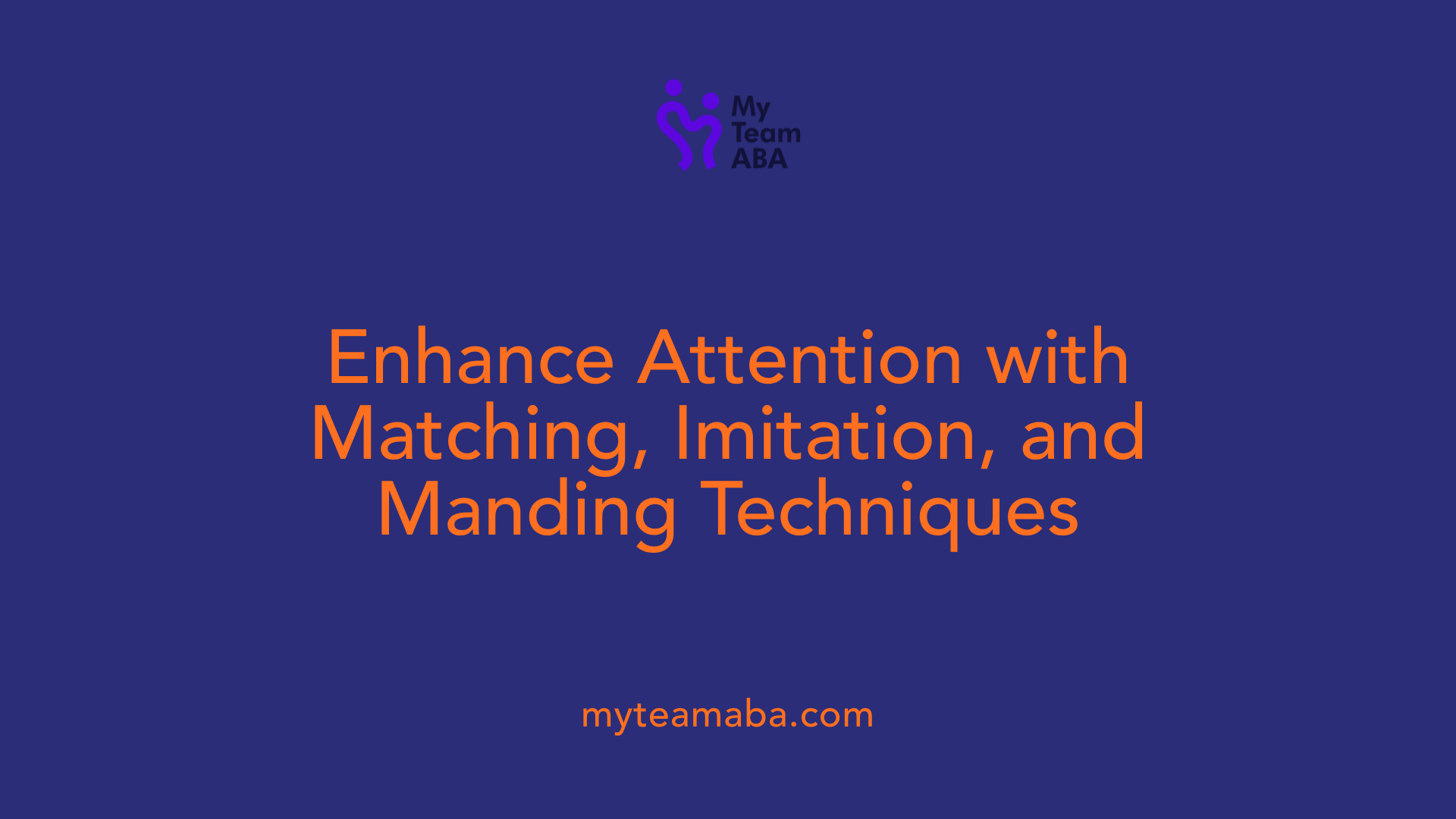
What specific ABA methods, like matching, imitation, and manding, are used to improve attention?
ABA therapy employs several structured strategies to boost attention span, focus, and social engagement in children. Among these, matching is a crucial technique that improves visual attention and memory. During matching tasks, children learn to identify and pair similar objects, pictures, or symbols. This exercise enhances their ability to scan visual details, recognize patterns, and remember information, all of which contribute to better concentration over time.
Imitation activities are another core component in ABA. In these exercises, children are encouraged to copy actions, gestures, sounds, or words demonstrated by therapists or caregivers. Repetition of imitation helps strengthen focus, eye contact, and engagement during conversations and play. It also promotes sensory processing and cognitive skills, making children more attentive to their environment.
Manding involves teaching children to request items or assistance using gestures, signs, or words. This method is vital for developing functional communication skills and teaches children to attend to social cues and conversational exchanges. When children learn to ask for what they need, their motivation to pay attention and participate in interactions increases.
In addition to these specific techniques, ABA interventions often incorporate positive reinforcement, visual modeling, prompting and fading, and task analysis. These approaches collectively aim to foster sustained attention, reduce distractibility, and promote independent task engagement.
Structured routines and modifications in the environment—such as minimizing distractions and establishing predictable activities—also support attention enhancement. Combining matching, imitation, and manding with environmental adjustments can significantly improve focus and behavioral self-control, empowering children to navigate social and learning settings more effectively.
Linking ABA Practices to Enhanced Attentional Skills
What is the connection between ABA practices and improved focus and attentional skills?
Applied Behavior Analysis (ABA) employs a variety of strategies that directly support the development of attention and focus in children. At its core, ABA uses reinforcement principles to promote behaviors associated with attention, such as sustained eye contact, responding to stimuli, and task engagement.
One fundamental method is breaking down complex tasks into smaller, manageable steps, making it easier for children to maintain focus. Positive reinforcement, such as praise, tokens, or rewards, encourages children to stay attentive and complete activities. Structured routines and clear instructions also help create an environment where children know what to expect, reducing distractibility.
ABA techniques like video modeling, peer-mediated teaching, and systematic prompting are effective in developing joint attention—a crucial social-communication skill involving shared focus. Improving joint attention directly correlates with enhanced overall attentional capabilities because children learn to concentrate on shared activities and social cues.
Addressing attention-seeking behaviors is another important aspect. These behaviors often disrupt learning and social interactions. ABA teaches children appropriate ways to seek attention through replacement behaviors, such as raising their hand or using communication devices. Techniques like planned ignoring of disruptive behaviors and reinforcement of desirable actions help reduce attention-seeking, fostering a more focused and positive learning environment.
Furthermore, ABA systematically teaches attention skills through activities such as matching games, imitation exercises, and visual scanning tasks. These activities improve visual attention, concentration, and memory. For example, matching objects or pictures enhances visual discrimination and focus.
Overall, ABA’s structured and evidence-based approach supports children in developing better focus by reinforcing attentive behaviors, teaching attention management strategies, and fostering social-pragmatic skills like joint attention. This comprehensive framework enhances their ability to engage meaningfully in educational, social, and everyday settings.
Harnessing ABA for Long-term Attention Benefits
ABA therapy's systematic and evidence-based strategies are instrumental in fostering improved focus and attentional skills in children. By combining reinforcement, structured routines, and engaging activities tailored to each child's needs, ABA helps children learn to control impulses, maintain attention longer, and participate actively in social and educational settings. The integration of techniques like matching, imitation, manding, and sensory activities further supports holistic development. As a result, children can achieve greater independence, better communication, and enhanced social integration, ultimately leading to a higher quality of life. Through ongoing support and personalized interventions, ABA remains a powerful tool for unlocking children’s full attentional potential.
References
- ABA Therapy for ADHD: Strategies to Improve Focus & Behavior
- Activities to Help Improve Attention Span in Autism
- How ABA Therapy Can Improve Communication Skills in Children
- 10 Effective Tips to Help Focus with Autism - Astra ABA
- Attention Improving Activities For Kids With Autism - Austin Center
- The Benefits Of ABA Therapy for Autism
- The Benefits Of ABA Therapy for Autism
